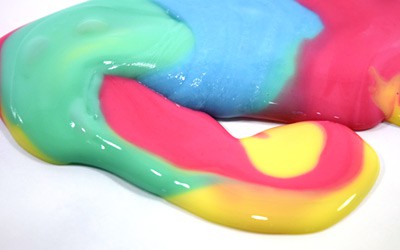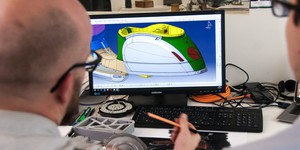Abstract
There are many different kinds of slime out there. Some slime is runny and liquid-like; other slime is thick and rubbery. Some slime glows in the dark, some is fluffy, and some is even magnetic! What set of properties makes the best slime? What kind of slime would you choose to make if you were selling slime as a toy in your own "slime shop"? In this project, you will experiment with different slime recipes and try to perfect one to make the best slime.Summary
Objective
Define desired properties for your slime, and then find the recipe that gives the best results.
Introduction
If you have ever played with slime, you know that it can be fun with all of its stretchy, bouncy, ickiness. Maybe you have noticed that some types of slime feel different than others. Have you ever wondered why slime behaves the way it does? It all has to do with chemistry. Chemistry is the study of matter, which is the stuff that everything around you is made of. Chemists are interested in finding out what different materials, such as slime, are made of, how these materials behave, and how they can be changed into other materials.
What is slime actually made of? If you have made slime before, you probably followed a recipe to put different ingredients together, similar to baking a cake. The ingredients used for slime usually include Elmer's® glue and borax. Elmer's glue is made up of a polymer. Polymers are long chain-shaped molecules.
The polymer chains in the Elmer's glue are long and very straight. The polymer chains can slide across each other easily, making the glue runny and "liquidy" (think of dumping a bunch of fresh-cooked spaghetti out of a pot). This changes, however, when you mix the glue with borax. The borax helps make connections between each of the polymer chains, as shown in Figure 1. This process is called crosslinking. This makes it harder for the polymer chains to slide around, making the glue thicker and turning it into "slime." In this project, you will use contact lens solution to make slime. It contains other ingredients (boric acid and sodium borate) that react with baking soda (another ingredient in your slime) to make borax.
 Image Credit: Ben Finio, Science Buddies / Science Buddies
Image Credit: Ben Finio, Science Buddies / Science Buddies
Figure 1. Straight polymer chains (left) are linked together by borax to form a cross-linked polymer (right).
You might wonder if changing the recipe changes the properties of the slime. In science, a property is something about a material that you can observe and measure, for example, its weight, color, or stickiness. There are many different types of slime with different properties. Some slime is thin and runny; some slime is thick and rubbery. You can add extra ingredients to slime to make it sparkly, magnetic, or glow-in-the-dark.
Terms and Concepts
- Chemistry
- Matter
- Polymer
- Crosslinking
- Properties
Questions
- If you could make any slime you wanted, what properties would you want it to have?
- What ingredients do you think you would need to give your slime those properties?
- Search online for slime recipes. What types of slime do you find recipes for?
Bibliography
- Rader, Andrew. (2005). Matter is the Stuff Around You. Rader's Chem4Kids. Retrieved December 13, 2005.
- Science Buddies Staff (n.d.). The Engineering Design Process. Science Buddies. Retrieved July 17, 2019.
Materials and Equipment
This is an engineering design project, the exact list of materials you need may vary slightly. To make a typical basic slime recipe, you will need:
- Washable PVA school glue (like Elmer's®)
- Water
- Baking soda
- Contact lens solution (must contain both boric acid and sodium borate in ingredients)
- Food coloring
- Measuring spoons
- Measuring cup
- Mixing bowl
- Spatula
- Resealable plastic bags or food storage containers
You can also try various additives to change the properties of your slime:
- Glitter (sparkly slime)
- Iron filings (magnetic slime)
- Glow-in-the-dark paint (glow-in-the-dark slime)
- Thermochromic pigment (color-changing slime)
- Tonic water (glow-in-black-light slime)
- Foam shaving cream (fluffy slime)
Disclaimer: Science Buddies participates in affiliate programs with Home Science Tools, Amazon.com, Carolina Biological, and Jameco Electronics. Proceeds from the affiliate programs help support Science Buddies, a 501(c)(3) public charity, and keep our resources free for everyone. Our top priority is student learning. If you have any comments (positive or negative) related to purchases you've made for science projects from recommendations on our site, please let us know. Write to us at scibuddy@sciencebuddies.org.
Experimental Procedure
- Watch the video to learn how to make a basic slime recipe. The video is available in Spanish too.
- In a mixing bowl, thoroughly mix 1/2 C water, 1/2 C glue, and a few drops of food coloring.
- Add 1/2 tsp baking soda and mix completely.
- Add 2 tbsp contact lens solution and stir vigorously until the mixture starts pulling away from the edges of the bowl.
- Use your hands to knead the slime for 5–10 minutes until its texture stops changing. Do not worry if the slime is very runny and sticks to your hands at first. It will continue to get thicker as you knead it. It gets easier to clean up the slime as you knead it more!
- If you have not already, do your own research online about slime recipes and different types of slime.
- Define criteria for your slime's properties. For example:
- What should your slime look like?
- What should your slime feel like?
- How thick should your slime be?
- How heavy should your slime be (dense and heavy or light and fluffy)?
- Should your slime have any special properties (magnetic, glow-in-the-dark, etc.)?
- Define how you will evaluate your slime's properties. Some of the properties and observations may be qualitative (for example, you want the slime to be sparkly, and you can determine how sparkly it is by looking at it). Some properties can be measured quantitatively. Table 1 gives some examples of quantitative properties and how you can measure them.
| Property | Measurement |
|---|---|
| Heaviness | Weigh a certain volume of slime |
| Bounciness | Drop a ball of the slime next to a ruler and measure how high the slime bounces |
| Stretchiness | Measure how far you can stretch the slime before it breaks |
| Thickness | Place a ball of slime on a flat surface and measure how quickly it spreads out to a circle of a certain diameter |
- Based on your background research, write down a recipe that you think will result in slime with these properties.
- Follow the recipe to make the slime. When you are done, observe your slime's properties and record them in a data table like Table 2.
| Slime Batch # | Recipe | Slime Properties |
|---|---|---|
| 1 | ||
| 2 | ||
| 3 | ||
| ... |
- Do your slime's properties exactly match the criteria you defined in step 3? If not, now it is time to iterate. This is an important part of the engineering design process. You may need to make changes to your slime recipe, try again, and evaluate how the properties changed.
- In general, it is important to only change one thing at a time. If you change two ingredients at once, you might not be able to tell which one resulted in a property change.
- If your recipe did not work at all, or came out very different from how you expected, you may need to go "back to the drawing board" or make more dramatic changes.
- Make changes to your recipe based on your observations and knowledge of what different ingredients contribute to the slime (for example, using more contact lens solution should make the slime thicker). Follow your new recipe to make another batch of slime and evaluate its properties.
- Keep iterating and testing new slime recipes until you have found a recipe that gives you slime with all the desired properties.
- Store each batch of slime in a separate, airtight container for future use. If you want to dispose of your slime, put it in the trash. Do not try to pour slime down the drain, or it will cause a clog.
Ask an Expert
Variations
- Do "product testing" for your slime. Recruit volunteers to play with different batches of slime. What type of slime do they like best? Use their feedback to help you iterate and improve your slime recipe.
Careers
If you like this project, you might enjoy exploring these related careers:












